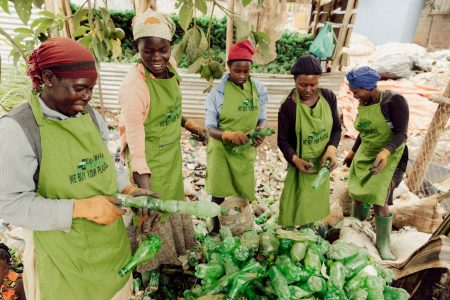Author: Nicole Crozier, Development Consultant
Addressing gender equality is fundamental to achieving the United Nations Sustainable Development Goals or SDGs by 2030. Reaching global gender parity faced a major setback due to COVID-19. Before the pandemic, gender parity was expected to be reached in 100 years, but in two years since the pandemic, the gap has widened to 132 years. The climate crisis and gender inequality are described as the greatest challenges of our time and it’s imperative that we acknowledge their interdependence when tackling them.
Gender inequality affects so many aspects of our lives, even how waste and plastics are used and discarded. Women play a pivotal role in unpaid household labour, the informal sector, purchasing decisions and waste management and often comprise a higher proportion of informal waste reclaimers than men in many developing countries. Informal waste reclaiming is hazardous work, with reclaimers facing discrimination, harassment and income vulnerability. In addition, women waste reclaimers in Ghana were found to collect the least valuable plastic types than their male counterparts. Women were also less likely to have access to financial resources or transportation than men working in the informal sector. Using a gender lens means considering gender roles, barriers and impacts along the value chain with the aim to set up plastic circular economy policies and interventions that support women’s rights, livelihoods and voice.
Fostering gender-responsive innovations through the Afri-Plastics Challenge
As part of the Afri-Plastics Challenge, innovators tackling plastic waste across Sub-Saharan Africa had to specifically account for how their solution would impact women and girls, and how women were consulted and included in the planning and implementation of their solution. Support offered as part of the Challenge looked at how gender roles and stereotypes harm men, women and gender diverse people. Over the last 18 months, innovators rose to the challenge by applying their learnings on the importance of operating their business with a gender lens. Innovators were encouraged to apply an intersectional approach to further consider gender in terms of ethnicity, religion, race and other identity factors.
The gender impact support offered to the innovators was practical and used frameworks, tools, discussion groups, co-mentorship and guest speakers. Innovators were encouraged to work within their sphere of influence: their business and their solution; to create a more diverse and inclusive environment. Each country and community is different and for some innovators this meant securing the support of traditional and religious leaders for the programme to even allow women to participate. Change can be difficult thus innovators discussed how to promote buy-in, through ensuring their organisation’s leadership was onboard and to bring men in as allies for gender inclusion. It was inspiring to see the Afri-Plastics Challenge finalists respond to the pressing issues affecting women in their communities and value chains as well as implement measures to promote gender equality.

Gender equality is not only common sense…it makes business sense
Promoting gender inclusion, diversity and equality in challenge prizes has a number of benefits. Firstly, there is a business rationale. It makes business sense to access diverse thinking on how different demographics of users and consumers will interact with products and services, what barriers they face, their values and needs. To solve the world’s most pressing problems, we need to understand women’s experience on them and women need to be included in the solutions.
Secondly, staff want to work for an organisation where they can be their authentic selves and which supports their diverse needs. Gender diversity and inclusion equates to better staff retention, financial performance and even better customer service.
- Financial performance: Workplace diversity in executive management was shown in a global study by McKinsey to improve company financial performance. Companies in the top quartile of gender diversity in executive management were 25% more likely to have above-average profitability than companies in the lowest quartile.
- Service Quality: Staff diversity has been found to improve patient care in hospitals and customer satisfaction ratings.
- Staff Turnover: Its not enough to hire a diverse team, inclusion is as important as diversity in improving representation within an organisation. Structural inequality and gender bias within organisations mean women are still disadvantaged in promotion and compensation, performance reviews and hiring processes. When the odds are stacked against women through the ‘Motherhood tax’, a lack of work life balance or signals that promotion opportunities are limited; staff turnover follows.
So, gender equality not only fulfills a moral imperative, it makes business sense as well.
Challenge innovators can use a gender lens from idea conceptualisation to scaling. Broad steps to undertake would include:
1. Considering your own assumptions and unconscious biases. As well as to consider how inequalities and prejudices in society bestow rank and privilege.
2. Consider structural inequalities within your community, sector or value chain and how that might influence the issue you are tackling as well as your customers, staff and suppliers.
3. Look to the data and especially data disaggregated by sex, race and other demographic factors. This will provide evidence to understand the position of women and other demographic groups.
4. Consult widely and inclusively with both men and women to understand their experience and challenges. Here great ideas can be generated to respond to the user’s needs.
5. Include gender equality in your vision, strategic plans, HR policies and budgets.
6. Communicate to your team and clients about your vision for gender inclusion and keep communicating even if progress stalls.
7. Bring gender equality into performance management by making leadership accountable.
8. Seek training and support to navigate this field.
Narrowing the gender gap is a continuous process. It requires identifying structural bias and inequalities, promoting inclusion as opposed to exclusion, consulting diverse groups of women and men, for leaders to ‘walk the talk’ and getting everyone on board to be a gender equality ally.
